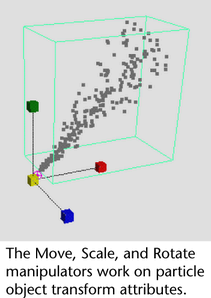You can animate particles in several ways:
- Animate transform attributes of a particle object (described in this section).
- Edit the , , or attributes on an individual particle basis. See Set attributes on a per particle basis.
- Use or modify the motion an emitter imparts to the particles it generates (see Emitters).
- Apply fields, such as gravity, to particles (see Overview of fields).
- Turn geometry into a collision object and bounce particles off it (see Particle collisions).
- Create goals for particles and make the particles follow the moving goal objects (see Goals).
To animate transform attributes of an entire particle object
- Select the particle object.
- Do one of the following:
- In the particle tab of the , enter values for the translate, scale, and rotate attributes.
- Use the , , and to manipulate the attributes.
- Set keys at the desired frames for the attributes. See Animation for details on setting keys.
NoteYou can key transform attributes of an entire particle object, not for individual particles in a particle object.
If you use a field or other forces on particles, you can also key the field’s transform attributes. See Work with fields.
